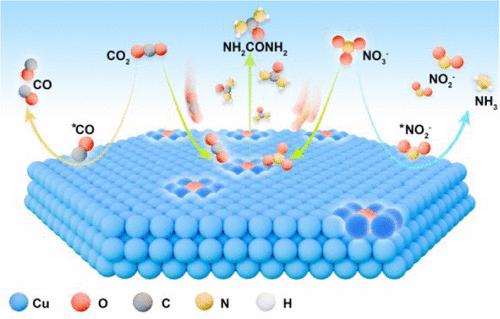Lattice Oxygen-Driven Co-Adsorption of Carbon Dioxide and Nitrate on Copper: A Pathway to Efficient Urea Electrosynthesis
IF 14.4
1区 化学
Q1 CHEMISTRY, MULTIDISCIPLINARY
引用次数: 0
Abstract
The electrochemical coupling of CO2 and NO3– on copper-based catalysts presents a sustainable strategy for urea production while simultaneously addressing wastewater denitrification. However, the inefficient random adsorption of CO2 and NO3– on the copper surface limits the interaction of the key carbon and nitrogen intermediates, thereby impeding efficient C–N coupling. In this study, we demonstrate that the residual lattice oxygen in oxide-derived copper nanosheets (OL-Cu) can effectively tune the electron distribution, thus activating neighboring copper atoms and generating electron-deficient copper (Cuδ+) sites. These Cuδ+ sites enhance CO2 adsorption and stabilize *CO intermediates, which enables the directional NO3– adsorption at adjacent Cuδ+ sites. This mechanism shortens the C–N coupling pathway and achieves a urea yield of up to 298.67 mmol h–1 g–1 at −0.7 V versus RHE, with an average Faradaic efficiency of 31.71% at a high current density of ∼95 mA cm–2. In situ spectroscopic measurements confirmed the formation of Cuδ+ sites and tracked the evolution of the key intermediates (i.e., *CO, *NO, *OCNO, and *NOCONO) during urea synthesis. Density functional theory calculations revealed that Cuδ+ sites promote adjacent coadsorption of *CO and *NO3, as well as *OCNO and *NO3, significantly improving C–N coupling kinetics. This study underscores the critical role of lattice oxygen in facilitating adjacent coadsorption and improving C–N coupling selectivity.

求助全文
约1分钟内获得全文
求助全文
来源期刊
CiteScore
24.40
自引率
6.00%
发文量
2398
审稿时长
1.6 months
期刊介绍:
The flagship journal of the American Chemical Society, known as the Journal of the American Chemical Society (JACS), has been a prestigious publication since its establishment in 1879. It holds a preeminent position in the field of chemistry and related interdisciplinary sciences. JACS is committed to disseminating cutting-edge research papers, covering a wide range of topics, and encompasses approximately 19,000 pages of Articles, Communications, and Perspectives annually. With a weekly publication frequency, JACS plays a vital role in advancing the field of chemistry by providing essential research.

 求助内容:
求助内容: 应助结果提醒方式:
应助结果提醒方式:


